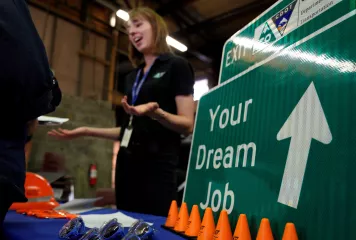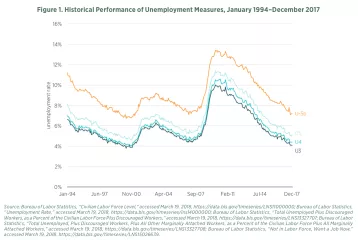- | Government Spending Government Spending
- | Expert Commentary Expert Commentary
- |
May Jobs Report Shows Strong Economic Growth despite Decline in Labor Force Participation
The Bureau of Labor Statistics (BLS) jobs report released today paints a surprising picture of a surging labor market. Job growth was stronger than expected while measures of unemployment continued to fall. The headline unemployment rate is at the lowest rate since April 2000, while the number of new unemployment insurance claims remains at the lowest level since the 1970s.
Employment
- Total nonfarm payroll employment increased by 223,000 jobs in May, higher than most expectations. Meanwhile the jobs growth estimates for March and April were revised upward by a net 15,000 jobs.
- The labor force participation rate dropped slightly to 62.7 percent.
- The headline unemployment rate (U-3) fell yet again to 3.8 percent.
- The number of long-term unemployed workers (27 weeks or longer) fell by 104,000 and has decreased by 29 percent over the last 12 months.
Some commentators have expressed concern that the lower unemployment rate is the result of decreasing labor force participation, but the simultaneous decline in other unemployment measures suggests that these fears are unwarranted.
- The discouraged worker unemployment rate (U-4) fell by 0.2 percent to 4.0 percentage points.
- The marginally attached unemployment rate (U-5) fell by 0.1 percent to 4.6 percentage points.
- The comprehensive jobless rate (U-5b) fell by 0.2 percentage points to 6.7 percent.
The comprehensive jobless rate is the most holistic measure of unemployment, counting everyone who doesn’t have a job and says that they want to work.
Indeed, the comprehensive jobless rate is proving its worth after two successive months where both the headline unemployment rate and the labor force participation rate decreased. Because the comprehensive jobless rate also fell during these months, we know that the decline in the unemployment rate is not simply a statistical artifact of the decrease in the labor force participation rate. The reduction is not the result of frustrated people giving up looking for work even though they still want a job, but represents broadly better labor market outcomes. It’s more likely that the lower rate of labor force participation reflects the increasing retirement of baby boomers.
This showcases the value of the comprehensive jobless rate—that it offers a benchmark against which to compare the official unemployment statistics reported by the BLS. This expansive definition of “joblessness” includes people who fall through the cracks in the BLS’s measurements, like frustrated job-seekers who haven’t actively looked for work in the last year and students who weren’t immediately able to take a job.
Wages
Similarly, many commentators have expressed surprise that wage growth—which was 2.7 percent over the previous 12 months—has not been stronger in an increasingly tight labor market. While this reaction is understandable, it misses a couple key points:
- Wage growth is only important in relation to the goods and services that the increased wages can buy. A better perspective would incorporate how fast wages are rising relative to the cost of living. After all, if both wages and inflation rise by 5 percent the average worker has not gained anything.
- Furthermore, because increasing wages themselves lead to higher production costs—and therefore rising inflation—we should not myopically root for higher wages.
Because inflation over the previous 12 months was 2.5 percent, the average worker’s wages have just barely maintained parity with the cost of living.
There are (at least) two potential explanations why wages (on average) are not growing faster:
- The labor market is not yet at full employment and employers in general are still able to find enough workers to avoid raising their wages to attract new job applicants. Given that there’s still 1.5 million part-time workers who would prefer full-time work, as well as millions more who say they want a job but are not actively searching right now, this argument has some merit.
- The number of part-time workers who can’t find full-time work fell by 106,000 to 1,480,000—which constitutes just 30 percent of people who work part-time because of economic reasons (which also includes temporary furlough or seasonal employment).
- Previous periods of high wage growth and low unemployment occurred when inflation was higher or productivity growth was stronger. It may be that low unemployment is insufficient to spur wage growth, and that additional conditions have to be met as well (such as lowering per-unit costs of production due to higher productivity or the ability to raise the sale price because customer incomes are also rising due to higher inflation).
In addition, the most often reported wage growth number is the average wage growth, which smears out more relevant industry and regional variation in income changes. For example, while average private industry hourly wages only rose by 2.7 percent over the last 12 months, the average hourly wages in retail trade rose by 4.4 percent. Similarly, average hourly wages rose by 3.9 percent in the construction industry and by 3.6 percent in nondurable goods manufacturing.
Next month we’ll get a chance to see if President Trump’s renewed trade war controversy slows the long-running growth in the job market.
Read more: A Better Way to Measure Unemployment


